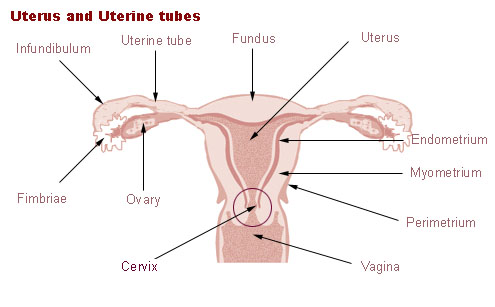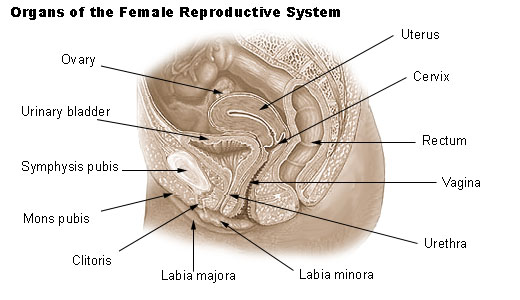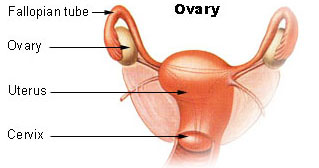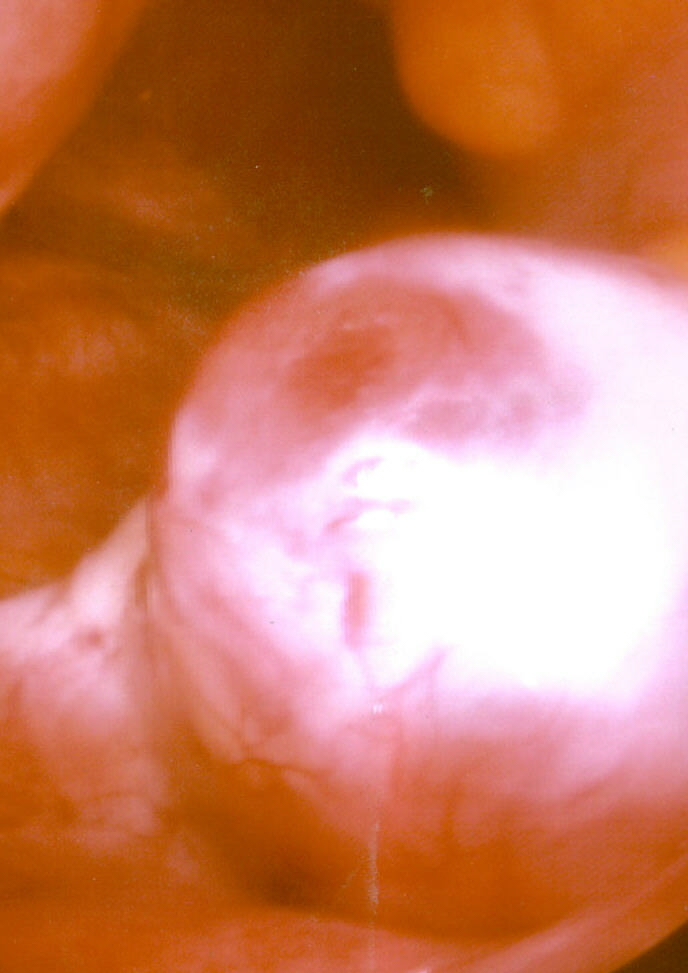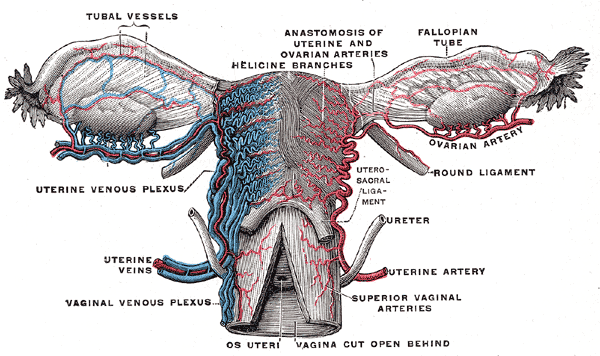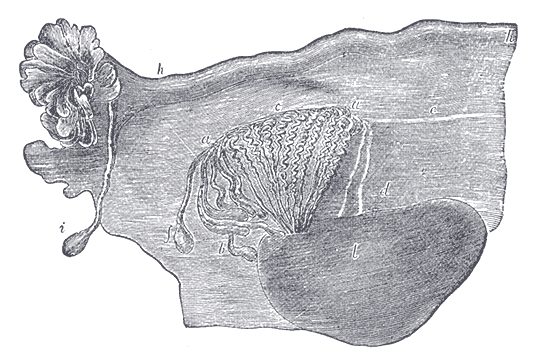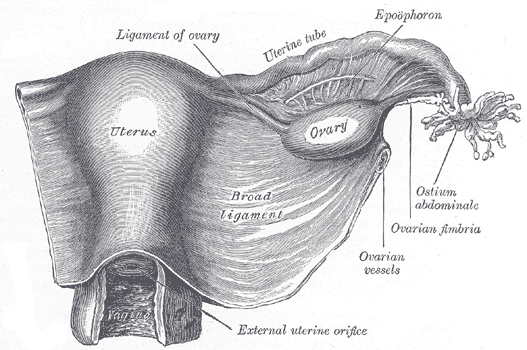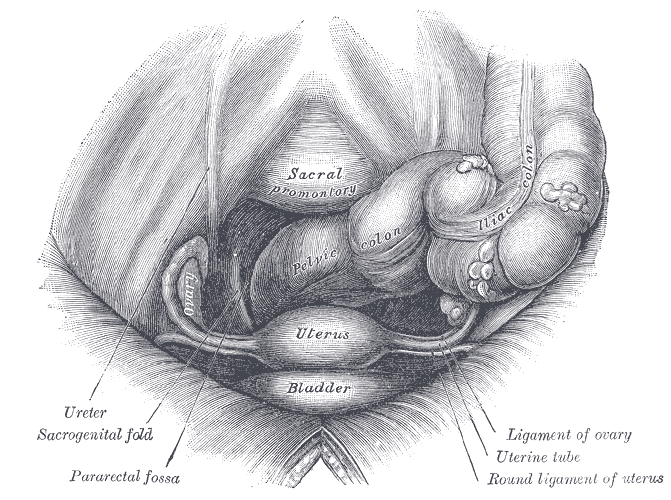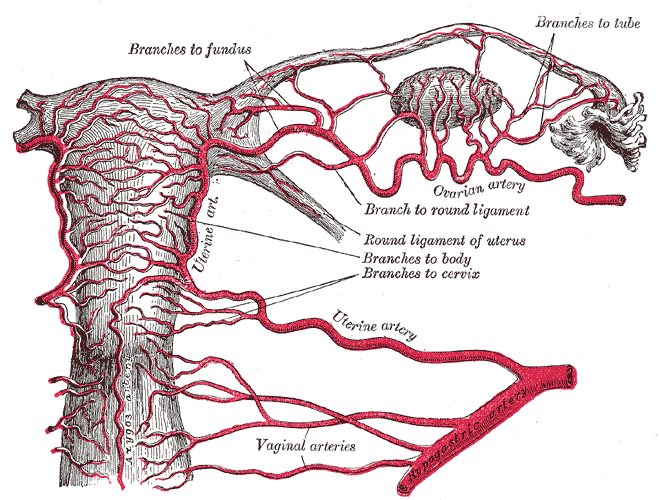Ovary
|
WikiDoc Resources for Ovary |
|
Articles |
|---|
|
Media |
|
Evidence Based Medicine |
|
Clinical Trials |
|
Ongoing Trials on Ovary at Clinical Trials.gov Clinical Trials on Ovary at Google
|
|
Guidelines / Policies / Govt |
|
US National Guidelines Clearinghouse on Ovary
|
|
Books |
|
News |
|
Commentary |
|
Definitions |
|
Patient Resources / Community |
|
Directions to Hospitals Treating Ovary Risk calculators and risk factors for Ovary
|
|
Healthcare Provider Resources |
|
Continuing Medical Education (CME) |
|
International |
|
|
|
Business |
|
Experimental / Informatics |
Editor-In-Chief: C. Michael Gibson, M.S., M.D. [1] Phone:617-632-7753
Overview
An ovary is an egg-producing reproductive organ found in female organisms. It is often found in pairs as part of the vertebrate female reproductive system. Ovaries in females are homologous to testes in males. The term gonads refers to the ovaries in females and testes in males.
Major Function
Production of eggs (exocrine)
As female mammals develop within the womb, each ovary develops a number of immature eggs associated with groups of other cells called follicles. While mammals were thought to develop their entire supply of eggs prenatally and soon after birth, new evidence from laboratory mice has called this into question, showing that female mice in fact produce new eggs throughout their reproductive lifetime[1], However, there is no direct evidence showing that human females produce new eggs after birth. As the animal becomes reproductively mature (the process called puberty in humans), eggs will periodically mature and be released from the ovary (a process called ovulation) so that they will be available for fertilization by sperm. A fertilized egg resulting from union with a sperm becomes a zygote and then an embryo as it develops.
In humans, an egg launched from an ovary has to traverse a slight space before entering the fallopian tube and moving gradually down to the uterus. If fertilized, it performs implantation into the lining of the uterus and develops as the pregnancy continues. If the fertilized egg settles into the fallopian tube instead of the uterus an ectopic pregnancy will result. Ectopic pregnancy can also happen if a fertilized egg settles onto the cervix or onto the ovary itself, or if a fertilized egg passes through the gap between the ovary and the fallopian tube into the abdomen.
Hormone secretion (endocrine)
Animal and human ovaries also produce various steroid and peptide hormones. Estrogen and progesterone are the most important of these in mammals.
These hormones serve many functions:
- They induce and maintain the physical changes of puberty and the secondary sex characteristics.
- They support maturation of the uterine endometrium in preparation of implantation of a fertilized egg.
- They provide signals to the hypothalamus and pituitary that help maintain the menstrual cycle.
- Estrogen plays an important role in maintaining subcutaneous fat, bone strength, and some aspects of brain function.
Human anatomy
Ovaries are oval shaped and, in the human, measure approximately 3 cm x 1.5 cm x 1.5 cm. The ovary (for a given side) is located in the lateral wall of the pelvis in a region called the ovarian fossa. The fossa usually lies beneath the external iliac artery and in front of the ureter and the internal iliac artery.
Ligaments
In the human the paired ovaries lie within the pelvic cavity, on either side of the uterus, to which they are attached via a fibrous cord called the ovarian ligament. The ovaries are uncovered in the peritoneal cavity but are tethered to the body wall via the suspensory ligament of the ovary. The part of the broad ligament of the uterus that covers the ovary is known as the mesovarium.
Extremities
There are two extremities to the ovary:
- The end to which the uterine tube attach is called the tubal extremity.
- The other extremity is called the uterine extremity. It points downward, and it is attached to the uterus via the ovarian ligament.
Vessels and nerves
Each ovary receives blood from the ovarian artery, which arises directly from the anterior abdominal aorta and the ovarian branch of the uterine artery that enters the ovary by way of the broad ligament and thus the mesovarium. The right ovarian vein drains to the inferior vena cava and the left ovarian vein drains to the left renal vein. The ovarian artery and vein are within the suspensory ligament of the ovary (infundibulopelvic ligament). Sources of innervation include the ovarian plexus.
Histology

- The outermost layer is the germinal epithelium.
- The tunica albuginea covers the cortex.
- The ovarian cortex consists of ovarian follicles and stroma in between them. Included in the follicles are the cumulus oophorus, membrana granulosa (and the granulosa cells inside it), corona radiata, zona pellucida, and primary oocyte. The zona pellucida, theca of follicle, antrum and liquor folliculi are also contained in the follicle. Also in the cortex is the corpus luteum derived from the follicles.
- The innermost layer is the ovarian medulla. It can be hard to distinguish between the cortex and medulla, but follicles are usually not found in the medulla.
Pathology
- If the egg fails to release from the follicle in the ovary an ovarian cyst may form. Small ovarian cysts are common in healthy women but large cysts can be an advanced manifestation of polycystic ovary syndrome.
- Ovarian cancer
- Hypogonadism
Additional images
-
Uterus and uterine tubes
-
Organs of the female reproductive system.
-
Ovary
-
An ovary about to release an egg.
-
Vessels of the uterus and its appendages, rear view.
-
Broad ligament of adult, showing epoöphoron.
-
Uterus and right broad ligament, seen from behind.
-
Female pelvis and its contents, seen from above and in front.
-
Arteries of the female reproductive tract: uterine artery, ovarian artery and vaginal arteries.
References
External links
- Your Shriveling Ovaries From SirensMag.com
See also
Template:Female reproductive system Template:Endocrine system
ar:مبيض bs:Jajnici bg:Яйчник ca:Ovari cs:Vaječník cy:Ofari da:Ovarium de:Eierstock dv:Ovary gl:Ovario ko:난소 id:Ovarium is:Eggjastokkur it:Ovaia he:שחלה la:Ovarium lt:Kiaušidė nl:Eierstok no:Eggstokk nn:Eggstokk sk:Vaječník sl:Jajčnik sr:Јајници fi:Munasarja sv:Äggstock uk:Яєчник
